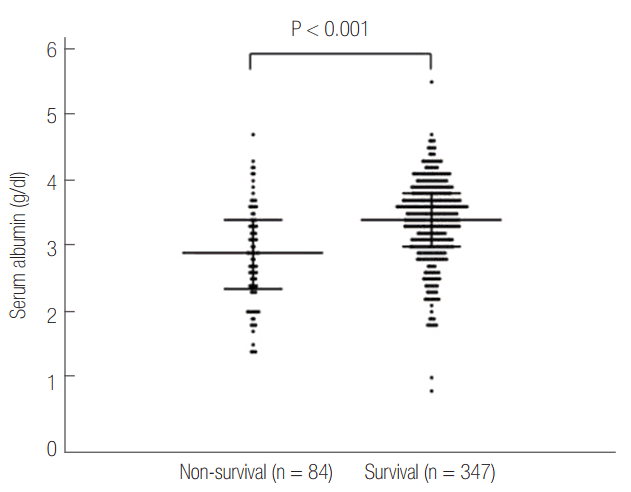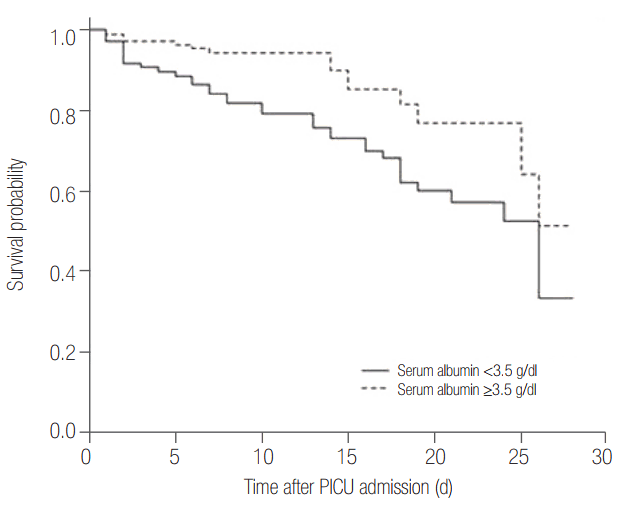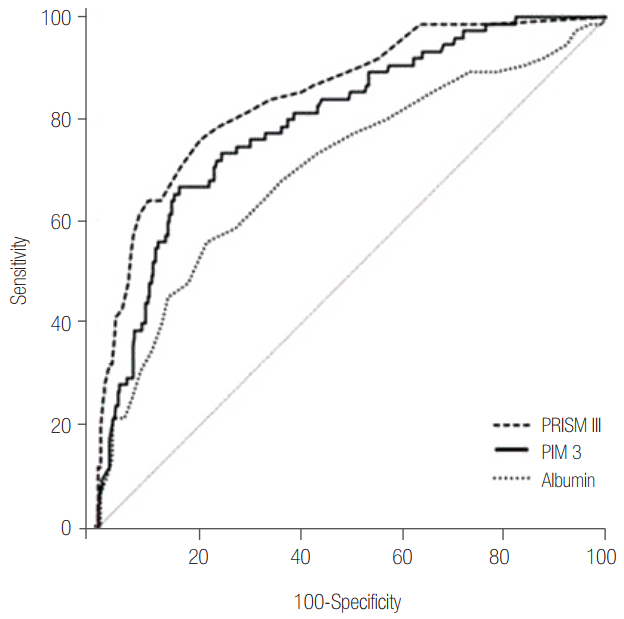Articles
- Page Path
- HOME > Acute Crit Care > Volume 32(4); 2017 > Article
-
Original Article
Pediatric Critical Care Serum Albumin as a Biomarker of Poor Prognosis in the Pediatric Patients in Intensive Care Unit -
Young Suh Kim1
 , In Suk Sol1,2
, In Suk Sol1,2 , Min Jung Kim1,2
, Min Jung Kim1,2 , Soo Yeon Kim1,2, Jong Deok Kim1,2
, Soo Yeon Kim1,2, Jong Deok Kim1,2 , Yoon Hee Kim1,3
, Yoon Hee Kim1,3 , Kyung Won Kim1,2
, Kyung Won Kim1,2 , Myung Hyun Sohn1,2
, Myung Hyun Sohn1,2 , Kyu-Earn Kim1,4
, Kyu-Earn Kim1,4
-
Korean Journal of Critical Care Medicine 2017;32(4):347-355.
DOI: https://doi.org/10.4266/kjccm.2017.00437
Published online: November 30, 2017
1Department of Pediatrics, Yonsei University College of Medicine, Seoul, Korea
2Department of Pediatrics, Severance Hospital, Seoul, Korea
3Department of Pediatrics, Gangnam Severance Hospital, Seoul, Korea
4Sowha Children’s Hospital, Seoul, Korea
- Correspondence to: Yoon Hee Kim, Department of Pediatrics, Gangnam Severance Hospital, Yonsei University College of Medicine, 211 Eonju-ro, Gangnam-gu, Seoul 06273, Korea Tel: +82-2-2019-3356, Fax: +82-2-2019-4881, E-mail: yhkim@yuhs.ac
• Received: August 2, 2016 • Revised: October 17, 2016 • Accepted: November 25, 2016
Copyright © 2017 The Korean Society of Critical Care Medicine
This is an Open Access article distributed under the terms of the Creative Commons Attribution Non-Commercial License (http://creativecommons.org/licenses/by-nc/4.0/) which permits unrestricted non-commercial use, distribution, and reproduction in any medium, provided the original work is properly cited.
Abstract
-
Background
- Serum albumin as an indicator of the disease severity and mortality is suggested in adult patients, but its role in pediatric patients has not been established. The objectives of this study are to investigate the albumin level as a biomarker of poor prognosis and to compare it with other mortality predictive indices in children in intensive care unit (ICU).
-
Methods
- Medical records of 431 children admitted to the ICU at Severance Hospital from January 1, 2012 to December 31, 2015 were retrospectively analyzed. Children who expired within 24 hours after ICU admission, children with hepatic or renal failure, and those who received albumin replacement before ICU admission were excluded.
-
Results
- The children with hypoalbuminemia had higher 28-day mortality rate (24.60% vs. 9.28%, P < 0.001), Pediatric Index of Mortality (PIM) 3 score (9.23 vs. 8.36, P < 0.001), Pediatric Risk of Mortality (PRISM) III score (7.0 vs. 5.0, P < 0.001), incidence of septic shock (12% vs. 3%, P < 0.001), C-reactive protein (33.0 mg/L vs. 5.8 mg/L, P < 0.001), delta neutrophil index (2.0% vs. 0.6%, P < 0.001), lactate level (1.6 mmol/L vs. 1.2 mmol/L, P < 0.001) and lower platelet level (206,000/μl vs. 341,000/μl, P < 0.001) compared to the children with normal albumin level. PIM 3 (r = 0.219, P < 0.001) and PRISM III (r = 0.375, P < 0.001) were negatively correlated with serum albumin level, respectively.
-
Conclusions
- Our results highlight that hypoalbuminemia can be a biomarker of poor prognosis including mortality in the children in ICU.
Introduction
Materials and Methods
Results
Discussion
Supplementary Materials
Figure 1.Albumin level in the first 4 days in intensive care unit in (A) normoalbuminemia group and (B) in hypoalbuminemia group. The box and plots represent mean and standard deviation.


Figure 2.Albumin level between non-survival and survival group. Serum albumin level in the survival group was higher than the non-survival group (3.4 g/dl [interquartile range, 3 to 3.8 g/dl] vs. 2.9 g/dl [interquartile range, 2.3 to 3.4 g/dl], P < 0.001). The error bar represents the median and interquartile range for each group.


Figure 3.Survival probability according to albumin level. Kaplan-Meier survival estimate for patients according to serum albumin level (albumin <3.5 g/dl vs. albumin ≥3.5 g/dl). This survival curve showed that the hypoalbuminemia group had lower survival probability than the normoalbuminemia group. PICU: pediatric intensive care unit.


Figure 4.Receiver operating characteristic curves for mortality between albumin and intensive care unit mortality scoring systems. Area under the receiver operating characteristic curve: PRISM III, 0.850 (95% CI, 0.801 to 0.899); PIM 3, 0.802 (95% CI, 0.747 to 0.858); albumin, 0.702 (95% CI, 0.633 to 0.772). PRISM: Pediatric Risk of Mortality; PIM: Pediatric Index of Mortality; CI: confidence interval.


Table 1.Underlying disease and main reason for ICU admission of pediatric patients
| Variable | No. (%) (n = 431) |
|---|---|
| Underlying disease | |
| Neurologic disease | 248 (57.54) |
| Hemato-oncologic disease | 78 (18.10) |
| Pulmonary disease | 23 (5.34) |
| Gastro-intestinal disease | 15 (3.48) |
| Cardiologic disease | 11 (2.55) |
| Endocrinologic disease | 6 (1.39) |
| Nephrologic disease | 6 (1.39) |
| Metabolic disease | 1 (0.23) |
| No underlying disease | 43 (10.00) |
| Main reason for ICU admission | |
| Airway-lung problem | 268 (62.18) |
| Neurologic problem | 64 (14.85) |
| Postoperation and procedure care | 37 (8.58) |
| Hemato-oncologic emergency | 15 (3.48) |
| Nephrologic problem | 14 (3.25) |
| Gastrointestinal problem | 9 (2.09) |
| Metabolic disease | 3 (0.70) |
| Othersa | 21 (4.87) |
Table 2.Subjects’ characteristics
Table 3.Characteristics in normoalbuminemia and hypoalbuminemia group
| Variable | Albumin <3.5 g/dl (n = 237) | Albumin ≥3.5 g/dl (n = 194) | P-value |
|---|---|---|---|
| Clinical characteristic | |||
| Age (yr) | 4.0 (1.6–8.8) | 2.0 (0.9–6.7) | NS |
| Male sex | 141 (59.49) | 120 (61.86) | NS |
| Nutritional state | NS | ||
| Well nourished | 151 (63.71) | 124 (63.92) | |
| Malnourished | 83 (35.02) | 66 (34.02) | |
| Obese (weight for age ≥97%) | 3 (1.27) | 4 (2.06) | |
| Main reason for ICU admission | |||
| Airway-lung problem | 151 (63.71) | 117 (60.31) | NS |
| Neurologic problem | 24 (10.13) | 40 (20.62) | NS |
| Postoperation and procedure care | 22 (9.28) | 15 (7.73) | NS |
| Hemato-oncologic emergency | 10 (4.22) | 5 (2.58) | NS |
| Nephrologic problem | 9 (3.80) | 5 (2.58) | NS |
| Gastrointestinal problem | 8 (3.38) | 1 (0.52) | NS |
| Metabolic disease | 1 (0.42) | 2 (1.03) | NS |
| Othersa | 12 (5.06) | 9 (4.64) | NS |
| Laboratory variable | |||
| White blood cell (/µL) | 9,190 (5,580–15,960) | 12,640 (7,685–18,603) | NS |
| Absolute neutrophil count (/µL) | 6,700 (3,303–11,763) | 8,922 (4,803–14,223) | NS |
| Delta neutrophil index (%) | 2.0 (0.0–7.1) | 0.6 (0.0–3.6) | <0.001 |
| Hemoglobin (g/dl) | 10.2 (8.8–11.4) | 11.0 (9.8–12.1) | <0.001 |
| Platelets (103/µl) | 206 (96–335) | 341 (232–475) | <0.001 |
| Erythrocyte sedimentation rate (mm/h) | 23.0 (7.0–64.5) | 19.5 (4.75–48.0) | NS |
| C-reactive protein (mg/L) | 33.0 (8.5–97.5) | 5.8 (0.9–24.2) | <0.001 |
| Lactate (mmol/L) | 1.6 (0.9–3.1) | 1.2 (0.7–1.9) | <0.001 |
| Length of ICU stay (d) | 10.0 (4.0–19.0) | 7.0 (4.0–17.0) | NS |
| ICU scoring system | |||
| PIM 3 | 9.23 (4.52–29.48) | 8.36 (3.80–18.80) | <0.001 |
| PRISM III | 7.0 (3.0–13.0) | 5.0 (0–10.0) | <0.001 |
| Mortality | 64 (27.00) | 20 (10.31) | <0.001 |
| 28-Day mortality | 59 (24.60) | 18 (9.28) | <0.001 |
| Sepsis | 53 (22.36) | 29 (14.95) | NS |
| Septic shock | 28 (11.81) | 5 (2.58) | <0.001 |
Table 4.Univariable logistic regression for independent factor in mortality prediction
- 1. Straney L, Clements A, Parslow RC, Pearson G, Shann F, Alexander J, et al. Paediatric index of mortality 3: an updated model for predicting mortality in pediatric intensive care. Pediatr Crit Care Med 2013;14:673-81.ArticlePubMed
- 2. Sitar ME, Aydin S, Cakatay U. Human serum albumin and its relation with oxidative stress. Clin Lab 2013;59:945-52.ArticlePubMed
- 3. Abiles J, de la Cruz AP, Castano J, Rodriguez-Elvira M, Aguayo E, Moreno-Torres R, et al. Oxidative stress is increased in critically ill patients according to antioxidant vitamins intake, independent of severity: a cohort study. Crit Care 2006;10:R146. ArticlePubMedPMC
- 4. Oettl K, Stauber RE. Physiological and pathological changes in the redox state of human serum albumin critically influence its binding properties. Br J Pharmacol 2007;151:580-90.ArticlePubMedPMC
- 5. Vincent JL, Dubois MJ, Navickis RJ, Wilkes MM. Hypoalbuminemia in acute illness: is there a rationale for intervention? A meta-analysis of cohort studies and controlled trials. Ann Surg 2003;237:319-34.ArticlePubMedPMC
- 6. Barchel D, Almoznino-Sarafian D, Shteinshnaider M, Tzur I, Cohen N, Gorelik O. Clinical characteristics and prognostic significance of serum albumin changes in an internal medicine ward. Eur J Intern Med 2013;24:772-8.ArticlePubMed
- 7. Jellinge ME, Henriksen DP, Hallas P, Brabrand M. Hypoalbuminemia is a strong predictor of 30-day all-cause mortality in acutely admitted medical patients: a prospective, observational, cohort study. PLoS One 2014;9:e105983.ArticlePubMedPMC
- 8. Nagumo K, Tanaka M, Chuang VT, Setoyama H, Watanabe H, Yamada N, et al. Cys34-cysteinylated human serum albumin is a sensitive plasma marker in oxidative stress-related chronic diseases. PLoS One 2014;9:e85216.ArticlePubMedPMC
- 9. Goldstein B, Giroir B, Randolph A, International Consensus Conference on Pediatric Sepsis. International pediatric sepsis consensus conference: definitions for sepsis and organ dysfunction in pediatrics. Pediatr Crit Care Med 2005;6:2-8.ArticlePubMed
- 10. Durward A, Mayer A, Skellett S, Taylor D, Hanna S, Tibby SM, et al. Hypoalbuminaemia in critically ill children: incidence, prognosis, and influence on the anion gap. Arch Dis Child 2003;88:419-22.ArticlePubMedPMC
- 11. Horowitz IN, Tai K. Hypoalbuminemia in critically ill children. Arch Pediatr Adolesc Med 2007;161:1048-52.ArticlePubMed
- 12. Tiwari LK, Singhi S, Jayashree M, Baranwal AK, Bansal A. Hypoalbuminemia in critically sick children. Indian J Crit Care Med 2014;18:565-9.ArticlePubMedPMC
- 13. Apelgren KN, Rombeau JL, Twomey PL, Miller RA. Comparison of nutritional indices and outcome in critically ill patients. Crit Care Med 1982;10:305-7.ArticlePubMed
- 14. Bradley JA, Cunningham KJ, Jackson VJ, Hamilton DN, Ledingham IM. Serum protein levels in critically ill surgical patients. Intensive Care Med 1981;7:291-5.ArticlePubMed
- 15. Murray MJ, Marsh HM, Wochos DN, Moxness KE, Offord KP, Callaway CW. Nutritional assessment of intensive-care unit patients. Mayo Clin Proc 1988;63:1106-15.ArticlePubMed
- 16. Marik PE. The treatment of hypoalbuminemia in the critically ill patient. Heart Lung 1993;22:166-70.PubMed
- 17. Leite HP, Fisberg M, de Carvalho WB, de Camargo Carvalho AC. Serum albumin and clinical outcome in pediatric cardiac surgery. Nutrition 2005;21:553-8.ArticlePubMed
- 18. Tancredi DJ, Butani L. Pretransplant serum albumin is an independent predictor of graft failure in pediatric renal transplant recipients. J Pediatr 2014;164:602-6.ArticlePubMed
- 19. Emerson TE Jr. Unique features of albumin: a brief review. Crit Care Med 1989;17:690-4.ArticlePubMed
- 20. Nicholson JP, Wolmarans MR, Park GR. The role of albumin in critical illness. Br J Anaesth 2000;85:599-610.ArticlePubMedPDF
- 21. Whicher J, Spence C. When is serum albumin worth measuring? Ann Clin Biochem 1987;24(Pt 6):572-80.ArticlePubMed
- 22. Fleck A, Raines G, Hawker F, Trotter J, Wallace PI, Ledingham IM, et al. Increased vascular permeability: a major cause of hypoalbuminaemia in disease and injury. Lancet 1986;1:781-4.ArticlePubMed
- 23. Goldwasser P, Feldman J. Association of serum albumin and mortality risk. J Clin Epidemiol 1997;50:693-703.ArticlePubMed
- 24. Seok Y, Choi JR, Kim J, Kim YK, Lee J, Song J, et al. Delta neutrophil index: a promising diagnostic and prognostic marker for sepsis. Shock 2012;37:242-6.ArticlePubMed
- 25. Ho KM, Lee KY, Dobb GJ, Webb SA. C-reactive protein concentration as a predictor of in-hospital mortality after ICU discharge: a prospective cohort study. Intensive Care Med 2008;34:481-7.ArticlePubMed
- 26. Agrawal S, Sachdev A, Gupta D, Chugh K. Platelet counts and outcome in the pediatric intensive care unit. Indian J Crit Care Med 2008;12:102-8.ArticlePubMedPMC
References
Figure & Data
References
Citations
Citations to this article as recorded by 

- Prognostic factors and models to predict pediatric sepsis mortality: A scoping review
Irene Yuniar, Cut Nurul Hafifah, Sharfina Fulki Adilla, Arifah Nur Shadrina, Anthony Christian Darmawan, Kholisah Nasution, Respati W. Ranakusuma, Eka Dian Safitri
Frontiers in Pediatrics.2023;[Epub] CrossRef - The association between serum albumin and long length of stay of patients with acute heart failure: A retrospective study based on the MIMIC-IV database
Tao Liu, Haochen Xuan, Lili Wang, Xiaoqun Li, Zhihao Lu, Zhaoxuan Tian, Junhong Chen, Chaofan Wang, Dongye Li, Tongda Xu, Chiara Lazzeri
PLOS ONE.2023; 18(2): e0282289. CrossRef - Pediatric Inflammatory Multisystem Syndrome Temporally Associated With SARS-CoV-2 (PIMS-TS) and Serous Effusions in a Child With Severe Hypoalbuminemia: A Case Report
Zohair El Haddar, Aziza Elouali, Ilham Belga, Maria Rkain, Abdeladim Babakhouya
Cureus.2023;[Epub] CrossRef - Inappropriate empirical antibiotic therapy was an independent risk factor of pediatric persistent S. aureus bloodstream infection
Xingmei Wang, Ziyao Guo, Xi Zhang, Guangli Zhang, Qinyuan Li, Xiaoyin Tian, Dapeng Chen, Zhengxiu Luo
European Journal of Pediatrics.2022; 182(2): 719. CrossRef - Evaluation of models for predicting pediatric fraction unbound in plasma for human health risk assessment
Yejin Esther Yun, Andrea N. Edginton
Journal of Toxicology and Environmental Health, Part A.2021; 84(2): 67. CrossRef - Diabetes Mellitus and Hypertension Increase Risk of Death in Novel Corona Virus Patients Irrespective of Age: a Prospective Observational Study of Co-morbidities and COVID-19 from India
Anirban Gupta, Neelabh Nayan, Ranjith Nair, Krishna Kumar, Aditya Joshi, Shivangi Sharma, Jasdeep Singh, Rajan Kapoor
SN Comprehensive Clinical Medicine.2021; 3(4): 937. CrossRef - Overview of Albumin Physiology and its Role in Pediatric Diseases
Charles B. Chen, Bilasan Hammo, Jessica Barry, Kadakkal Radhakrishnan
Current Gastroenterology Reports.2021;[Epub] CrossRef - The effect of nutritional status on post-operative outcomes in pediatric otolaryngology-head and neck surgery
Jordan Luttrell, Matthew Spence, Hiba Al-Zubeidi, Michael J. Herr, Madhu Mamidala, Anthony Sheyn
International Journal of Pediatric Otorhinolaryngology.2021; 150: 110875. CrossRef

 KSCCM
KSCCM
 PubReader
PubReader ePub Link
ePub Link Cite
Cite





